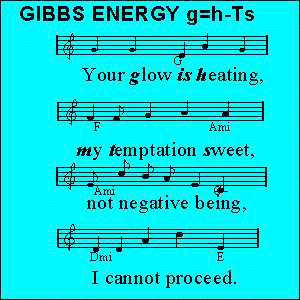Summary:
The amount of heat (dq) transferred from the surroundings
to a unit mass at a constant volume equals the specific internal energy increase
(du=dq| V=const ),
while the heat transfer at a constant pressure increases enthalpy
(dh=dq| p=const ).
Supplied heat increases temperature du=cv.dT, dh=cp.dT, with the
exception of phase changes, where latent heat of vaporisation (dhLG=rLG), heat of
fusion (dhSL=rSL) or heat of sublimation (dhSG=rSG) are added at T=const. Liquids and
solids are nearly incompressible, so that we need not consider mechanical work in
energy balances (in this case the specific heat capacities are equal c p =c v and the
relation between the amount of heat transferred to a body and the temperature
increase is q=c v T=c p T ). When mechanical work cannot be neglected
(compressible substances, usually gases) cp is greater than cv and the more general
definition of enthalpy
h=u+pv must be used.
Some phase equilibrium phenomena accompanied by heat transfer have
been described qualitatively (boiling, melting and sublimation) and the two simple
empirical relationships between temperature of boiling and pressure have been
presented:
T=100 p1/4
for water (we can extend this simple power-law model for
other liquids, too,
T/Tc=(p/pc)m ,
where Tc is critical temperature, pc is critical pressure
and the exponent m can be calculated from the boiling point temperature at
atmospheric pressure). More accurate is the
Antoine equation ln p = A-B/(T+C),
parameters A,B,C are presented in Tab. 7.1, or in Šesták (1981).
Heat released or consumed by a chemical reaction can be evaluated
according to Hess's law from the tabulated enthalpies of formation (Df)298. The
actual reaction is replaced by hypothetical reactions describing decomposition of
reagents to free elements (at the most stable state, e.g., C, S, O2, H2,...) and by
subsequent formation of products from these free elements. The enthalpy of
formation equals the enthalpy of decomposition (with the opposite sign) and thus the
reaction heat is the difference between the enthalpies of formation of products and
reactants. This difference can be calculated as the sum of enthalpies of formation of
all species involved in the reaction using stoichiometric coefficients as DH=åjiDhf
(remember: stoichiometric coefficients of reactants are negative).
The first law of thermodynamics expresses the principle of energy
conservation, stating that the amount of heat transferred to a closed system (dQ)
equals the sum of the internal energy increase (dU) plus volumetric mechanical work
(p.dV) done by the system
dQ=dU+p.dV
(the symbol dQ emphasises the fact that heat Q is
not a state variable and its change dQ is not a unique function of ending states). Remark: For other
forms of work the more general formulation has to be used: dQ=dU+p.dV+s.dA+U(e).dQ(e), where s.dA
is the mechanical work done by the change of surface dA (s is the surface stress) and U(e).dQ(e) is
electrical work corresponding to transfer of electrical charge dQ(e) between electrical potential U(e).
The second law of thermodynamics states that entropy S, a measure of the
spontaneity of processes, always increases in a closed, thermally insulated system.
Change of entropy can be computed by integration of dS=(dQ/T)rev
,
where dQ is heat
transferred to the system in a reversible way. Generally dS=dQ/T+dSirrev, where dQ is
the actual amount of heat transferred across the boundary of the system, and dSirrev
is the part of the entropy change caused by irreversible processes inside the system.
The spontaneity of the processes taking place in a system at constant temperature
and pressure (e.g., at phase changes) can be more comfortably evaluated from
Gibbs energy defined as G=H-TS.
Spontaneous processes are characterised by
decreasing Gibbs energy G (note the negative sign in the definition G » -S). The
negative value of the Gibbs energy change dG of a transformation A>B (a reaction,
phase change,etc.) means that the transformation A>B is more probable than B>A.
Thus dG=0 is a condition describing, e.g., the equilibrium of chemical reactions.
Similarly, Helmholtz energy, used to express equilibrium at constant pressure and
volume is defined as F=U-TS. The conditions V,p=const are not so frequently
encountered in engineering practice, and for this reason we pay little attention to F.
These three thermodynamic functions (S-entropy, G-Gibbs energy, F-
Helmholtz energy) have the same meaning, i.e., their changes characterise
spontaneity of processes under different external conditions, see the following table:
Songs for fun:
SECOND LAW
Remove borders
and processes are starting
all attempts go back are vain.
I hate the entropy,
precluding,.
me to be born again.

·
@TEC: 3. 3.2003
Change language to


 peoples
peoples


 mailto: Zitny
mailto: Zitny

